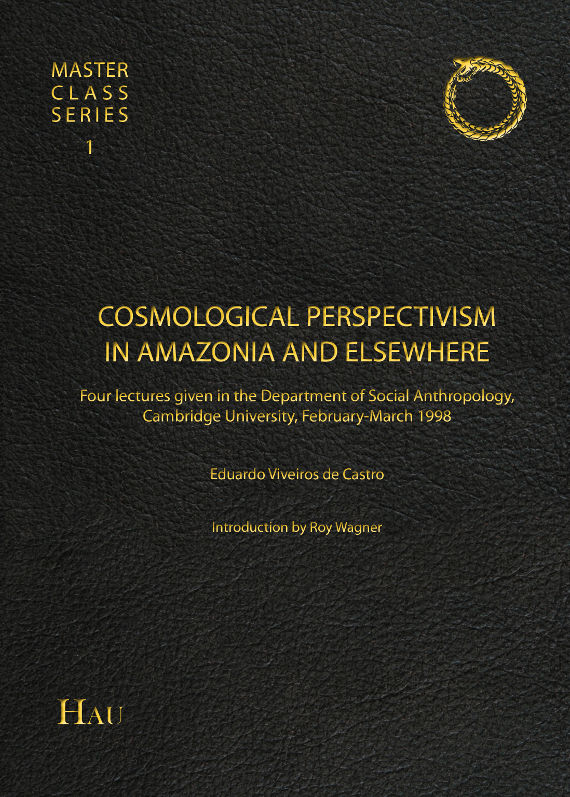Eduardo Viveiros de Castro: Cosmological Perspectivism in Amazonia and Elsewhere (2012)
Filed under book | Tags: · animal, anthropology, body, cosmology, culture, ethnography, indigenous peoples, nature, object, ontology, perspective, perspectivism

“A tour-de-force in the anthropology of ours and other cosmologies. The first official version of the lessons which sparked one of the most influential anthropological movements of the twenty-first century. Four lectures given in the Department of Social Anthropology, Cambridge University, February-March 1998.” (from the back cover)
“The subject of these lectures is that aspect of Amerindian thought which has been called its “perspectival quality” or “perspectival relativity”: the conception, common to many peoples of the continent, according to which the world is inhabited by different sorts of subjects or persons, human and nonhuman, which apprehend reality from distinct points of view. I shall try to persuade you that this idea cannot be reduced to our current concept of relativism, which at first it seems to call to mind. In fact, it is at right angles, so to speak, to the opposition between relativism and universalism.” (from page 45)
With an Introduction by Roy Wagner
Publisher HAU, Manchester, 2012
HAU Masterclass Series, 1
Creative Commons Attribution-NonCommercial-NoDerivs 3.0 Unported
ISSN 2049-4769
168 pages
PDFs, EPUBs, HTML (from the publisher)
single PDF (6 MB)
For more from Viveiros de Castro see Monoskop wiki.
Comment (0)Common Knowledge 17(1): Comparative Relativism: Symposium on an Impossibility, I-IV (2011)
Filed under journal | Tags: · anthropology, comparative relativism, ethnography, history, knowledge, philosophy of science, politics, science, sociology of science

A journal section based on the conference “Comparative Relativism” held in September 2009 at the IT University of Copenhagen.
The aim of this publication “is to place in unlikely conjunction the two terms ‘comparison’ and ‘relativism’. On the one hand, comparison, in the most general sense, involves the investigation of discrete contexts to elucidate their similarities and differences. Comparative methods have been widely used in many social science disciplines, including history, linguistics, sociology, and anthropology. On the other hand, relativism, as a tendency, stance, or working method in social anthropology, and more recently in science and technology studies (STS), usually involves the assumption that contexts exhibit, or may exhibit, radically different, incomparable, or incommensurable traits.”
Based on this paradoxical premise, “comparative relativism is understood by some to imply that relativism comes in various kinds and that these have multiple uses, functions, and effects, varying widely in different personal, historical, and institutional contexts; moreover, that those contexts can be compared and contrasted to good purpose…On the other hand, comparative relativism is taken by other[s] to imply and encourage a ‘comparison of comparisons’, in order to relativize what different peoples—say, Western academics and Amerindian shamans—compare things “for’.” (from the Introduction)
“In other words, comparative relativism can ask both what knowledge or truth is being imagined relative to and whether comparison always operates in the “same” way—or with the same grounds or purposes (e.g., shoring up the categories of culture, nature, morality) wherever we find it.” (from Helmreich 2012)
With contributions by Casper Bruun Jensen, Barbara Herrnstein Smith, G. E. R. Lloyd, Martin Holbraad, Andreas Roepstorff, Isabelle Stengers, Helen Verran, Steven D. Brown, Brit Ross Winthereik, Marilyn Strathern, Bruce Kapferer, Annemarie Mol, Morten Axel Pedersen, Eduardo Viveiros de Castro, Matei Candea, Debbora Battaglia, and Roy Wagner.
Publisher Duke University Press, Winter 2011
ISBN 0961-754x
165 pages
PDF (4 MB)
See also
Casper Bruun Jensen, Bifurcations: Comparative Relativism, Conexões Parciais, 2012, 21 pp.
Stefan Helmreich, Extraterrestrial Relativism, Anthropological Quarterly, 2012, 15 pp.
Cultural Anthropology 25(4): Multispecies Ethnography (2010)
Filed under journal | Tags: · anthropology, biology, biopolitics, ecology, ethnography, multispecies, nature
“A new genre of writing and mode of research has arrived on the anthropological stage: multispecies ethnography. Creatures previously appearing on the margins of anthropology—as part of the landscape, as food for humans, as symbols—have been pressed into the foreground in recent ethnographies. Animals, plants, fungi, and microbes once confined in anthropological accounts to the realm of zoe or “bare life”—that which is killable—have started to appear alongside humans in the realm of bios, with legibly biographical and political lives. Amid apocalyptic tales about environmental destruction, anthropologists are beginning to find modest examples of biocultural hope—writing of insect love, of delectable mushrooms that flourish in the aftermath of ecological destruction, and of microbial cultures enlivening the politics and value of food.
Multispecies ethnographers are studying the host of organisms whose lives and deaths are linked to human social worlds. A project allied with Eduardo Kohn’s “anthropology of life”—“an anthropology that is not just confined to the human but is concerned with the effects of our entanglements with other kinds of living selves”—multispecies ethnography centers on how a multitude of organisms’ livelihoods shape and are shaped by political, economic, and cultural forces. Such ethnography also follows Susan Leigh Star, who suggests “it is both more analytically interesting and more politically just to begin with the question, cui bono? than to begin with a celebration of the fact of human/non-human mingling”.” (from the Introduction)
Edited by Eben Kirksey and Stefan Helmreich, with contributions by Eva Hayward, Agustin Fuentes, Celia Lowe, and Jake Kosek.
PDF (updated on 2015-2-13)
Additional material (journal website)


